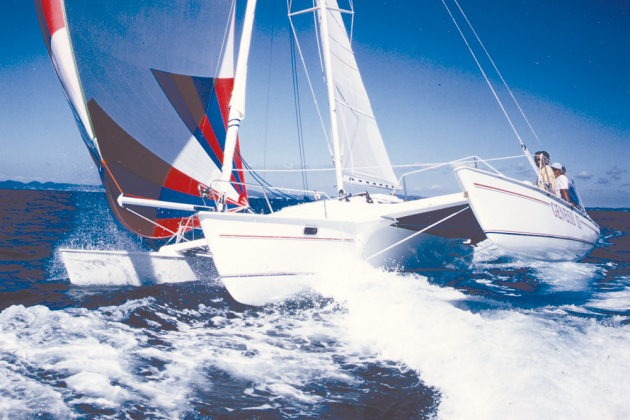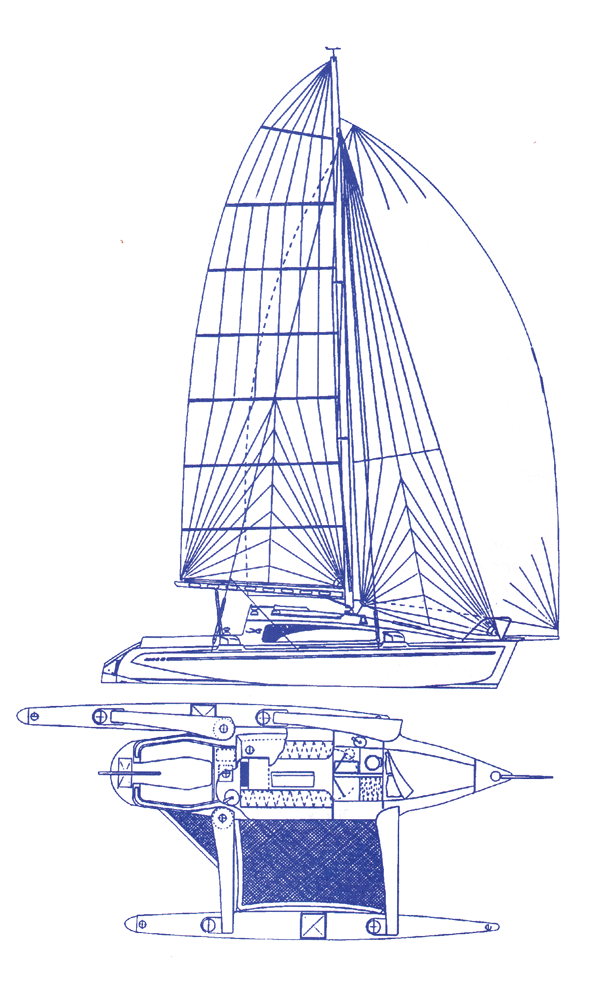The Contour 30
This robust folding trimaran happily fills a niche in performance sailing
Apowerboating friend (yes, I have a few of them) told me the other day that sailing has become just a niche sport; an esoteric pursuit for those of us chained to an ancient method of transportation that's sure to fade away for good one sad day. I don't buy it. Just for the record, let's understand that sailing is the one true conduit to the sea. Sailing, in the current lingo, is the mother of all links. Nothing unleashes the imagination like sailing. Nothing inspires ingenuity like sailing. To hell with the naysayers and to my friend. Without sailing, water is just water, something to drink not something to write poems about. 
Still, just for fun, let's carry his niche argument a bit further. If sailing is a niche, then multihull sailing is the proverbial niche within a niche. We're not finished yet, within the niche of multihull sailing, there's trimaran sailing, and more specifically still, there are folding trimarans for those who don't have the facilities to dock or moor a beamy trimaran. They're a niche within a niche within a niche within a niche. Anyway, you get the point.
The Contour 30 is an intriguing folding trimaran that represents a sound value in today's hard-to-pin-down used boat market. Those who lust after Contour 30s don't care that they're the ultimate niche yacht, they're after the unprecedented blend of performance, practicality and innovation they represent. 
The Contour was designed by Cole Beadon and built by Paul Countouris (hence the name) in Erin, Ontario. Countouris was one of the pioneers of folding trimarans and his earlier Dragonfly 25 is much desired by folding-tri sailors. The Contour 30 offers the same scintillating performance and ingenuity of the Dragonfly, with retracting amas making it slip friendly, but also includes enough of an interior to make weekend cruising viable, and for the spartan-minded, long-term cruising optional. I remember seeing a Contour 30 hauled up on the beach at Great Guana Cay in the Abacos. The young couple aboard were enjoying a six-month sailing sabbatical in the thin waters of the Bahamas. The Contour 30 was launched in 1991. A MK II model was offered in 1994.
First impressions
Your first impression of the Contour 30 will depend on whether you spot it underway with its wings spread wide, zipping across the water effortlessly, or if you are walking the docks and see it squeezed into a slip with its amas pulled in tight to accommodate the pilings. Either way it stands out. There's even a third way you might first see a Contour 30, riding on a trailer heading down the interstate. Yes, the Contour 30 is also trailerable and with a total weight of just over 3,000 pounds, you don't need a huge gas guzzler to drag it to your favorite cruising ground. The board-up draft is just over a foot, making it launchable at almost any ramp.
Let's take the first view, as it's definitely the nicest. The Contour 30 has an LOA of 30 feet and sailing beam of just about 24 feet. It really does looks like a huge dragonfly on the water. The sail area, including a big roachy mainsail and small jib, (it's self-tacking on the MK II models,) is 510 square feet. The SA/D is somewhere around 42 depending on how you calculate the roach, but anyway you do the numbers, the Contour 30 flat out flies. And it sails flat too. It is surprising to watch a Contour 30 working upwind at 8 knots without a hint of heel. The board down draft is 5 feet, 9 inches and the 30 tracks better than you might guess.
Construction
Construction is the key to the Contour 30. The boat must be light to be fast and it must be soundly engineered to make the entire concept work. The centerline hull and the amas are elliptically shaped and balsa cored with Kevlar reinforcements. Klegecell closed-cell foam coring is used in areas where water penetration is possible and solid glass is used in high-load sections. The amas have three watertight compartments. The retracting gear consists of aluminum crossbeams that pivot around stainless pins with Teflon bearings at the crossbeam and hull joints. The interior components are primarily molded pieces and with secondary bonds to hull sections.
What to look for
Before looking at specific items, let's examine some differences between the models. The MK II was usually set up with a self-tacking jib, and also included a better rotating mast. Also, most MK IIs came with the full roach main for better performance. Other updates included interior tweaks like brighter veneers and better lighting.
Examining a used folding trimaran is not unlike looking at any used boat. Carefully inspect the standing rigging and also take a hard look at the retracting gear. The engine on the Contour 30 is easy to inspect, it is almost always an outboard. Despite the cored construction, delaminating does not seem to be an issue with older boats. Of course, old is relative, as all of these boats date from the 1990s and many reside on freshwater lakes and other cruising grounds that have short sailing seasons, limiting wear and tear. One thing to be aware of is that when you start looking at used Contours you are on your own, as there's not much support out there.
On deck
The cockpit is all about sailing, and that's the way it should be. Most sail controls are led aft to the coachroof coaming. The mainsheet traveler, often a Harken system with an 8-to-1 purchase, runs across the cockpit just aft of the bridgedeck. It's a bit short but that's the nature of the design, the center hull is relatively narrow. The kick-up tiller is hung from the small, open transom. The helmsman sits to either side and there's good support and visibility. The primary sheet winches are mounted on pads and easily reached from the helm. The boat is set up for single-handed sailing.
The side decks, at least along the main hull, are narrow, but there are stainless handrails on the cabintrunk. Once the amas are pinned in place and the net between attached, there is plenty of deck space! The mast has an air draft of 44 feet and, as noted earlier, rotates for better performance. Running backstays are almost always fitted. A stainless vang keeps the mast from over rotating. The self-tacking jib on the MK II, (and some original boats) incorporates another Harken traveler with the leads led aft. There isn't much of a chain locker or provision for anchoring, however, with beaching a possibility, anchoring is not as alluring.
Down below
The interior of the Contour 30 is not for the claustrophobic. Yes, it's tight, but considering the overall space, it's quite clever. I could easily spend some time aboard a 30, and the earlier mentioned couple gunkholing around the Bahamas seemed quite content.
When you drop below, the small galley is to starboard. It includes a sink, a decent-sized icebox and usually a single burner stove, often an Origo non-pressurized alcohol stove. The electrical panel is mounted on the aft bulkhead. The narrow saloon features two settees, both of which can be used for berths, and there's a bit of storage behind and below.
Continuing forward, the head is squeezed to port. The advantage of this arrangement is that you don't have to crawl through the head to get to the V-berth. Speaking of the V-berth, it's quite nice, and two people who like each other will be comfortable. Speaking of the head, some owners opted for pressure-water systems with a shower in the head. The interior finish is white fiberglass with bits of wood veneer trim. There's good natural lighting and great ventilation with opening hatches and several opening port lights. It is ironic that most of these boats seem to be located in northern waters because they're ideal for the tropics.
Engine
The Contour 30 was designed for outboard engines. A 9.9 Yamaha seems to be a popular choice of boats on the used market. A four-stroke engine is a bit heavier but it burns much cleaner and is also smoother running and quieter. Most boats are set up with electric starting. The 9.9 horsepower pushes the 30 along at 6-plus knots. Another advantage of an outboard is that it can be hauled to a mechanic for servicing and repair work and also be stored when the boat is not being used.
Underway
I was fortunate to sail aboard the Contour 30, and its larger sisterships, the 34 and 50, when I reviewed them as new boats. The day we sailed the 30 in Florida, we hit 12 knots on a reach with 12 knots of true wind. It was impressive to say the least. The helm is light, even when sailing very fast. And it often feels windy because unless you are on a deep reach, the apparent wind is bending forward as the boat speeds along, causing increased apparent wind. Off the wind, the speed is intoxicating as the Contour 30 surfs easily. For those accustomed to conning multihulls through the wind, they'll be pleasantly surprised by how readily the Contour 30 tacks. You won't have to resort to jibing this multihull when you want to change course. I remember tacking up the narrow channel back to the marina just to prove the point to a skeptical writer from another magazine. A critical aspect of the design is the ama displacement. It's 180 percent, which means that it will support 1.8 times the weight of the entire boat, so it's robust and buoyant. It is very unlikely that the leeward ama will be buried in a seaway, although this is something that must be avoided in severe conditions.
Conclusion
I like the Contour 30, it's a great sailing boat with unmatched versatility. It is well constructed and has a small but enthusiastic following. There will always be a market for a boat that can sail 15 knots.
LOA 30'
LWL 28'6"
Beam 23'10"/11"
Draft (board up) 1'4"
Draft (board down) 5'9"
Displacement 3,000 lbs.
Sail Area 510 sq. ft.

Comments